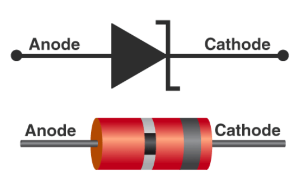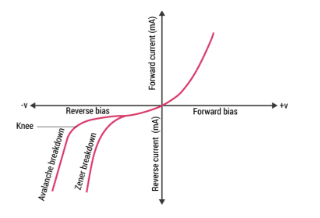Zener diodes are the devices that facilitate current flow in both forward and reverse directions. As ubiquitous semiconductor diodes, Zener diodes hold pivotal significance in electronic circuits. Therefore, read the article below to know what is Zener diodes, their definition, reverse bias operation, breakdown mechanisms (including avalanche breakdown and Zener breakdown), Zener diode symbols, V-I characteristics, and applications of Zener diode.
What is Zener Diode?
Zener diodes are the devices that facilitate current flow in both forward and reverse directions. It’s special because it works backwards, unlike most electronic parts. When you flip the electric power, and it reaches a certain point (the Zener Voltage), it lets the electric current go the other way. This special thing is called the Zener Effect, and it makes Zener Diodes handy in electronics for specific tasks.
Zener Diode Definition
A Zener diode is a special semiconductor gadget made to work the opposite way. It’s supercharged with various Zener voltages (Vz), and some types can even be adjusted to control different voltages. These are like a tool in electronics that can handle things going backwards and has a range of voltage superpowers, making it useful for controlling and adjusting voltages in different electronic devices.
Zener Diode as Voltage Regulator
How does zener diode work in reverse bias? A Zener diode operates akin to a conventional diode in forward-biased mode. However, during reverse-biased conditions, a nominal leakage current traverses the diode. The diode begins to conduct current as the reverse voltage escalates and attains the pre-established breakdown voltage (Vz). This current achieves a maximum level dictated by the series resistor and stabilises, persisting consistently over a broad spectrum of applied voltages.
Avalanche Breakdown in Zener Diode
When exposed to elevated reverse voltage, avalanche breakdown can manifest in both standard diodes and Zener diodes. Free electrons acquire sufficient energy to accelerate at heightened speeds when applying a substantial reverse voltage across the PN junction. These accelerated electrons undergo collisions with other atoms, leading to the liberation of additional electrons. This continuous collision generates many free electrons, precipitating a swift surge in electric current through the diode.
In the case of a conventional diode, this abrupt escalation in current could inflict permanent damage. However, a Zener diode is meticulously engineered to endure avalanche breakdown and manage the abrupt spike in current. Avalanche breakdown typically transpires in Zener diodes with a Zener voltage (Vz) surpassing 6V.
Zener Breakdown in Zener Diode
As the reverse bias voltage applied to a Zener diode nears its Zener voltage, the electric field within the depletion region becomes potent enough to pull and detach electrons from their valence band. These energised valence electrons, influenced by the intense electric field, detach from their parent atoms. This occurrence unfolds in the Zener breakdown region, where even a minor uptick in voltage triggers a swift upsurge in electric current.
Avalanche Breakdown vs. Zener Breakdown
The Zener effect is more noticeable at voltages up to 5.6 volts, and beyond that point, the avalanche effect becomes more prominent. While both effects share similarities, the key difference is that the Zener effect is a quantum phenomenon, whereas the avalanche effect involves the movement of electrons in the valence band, akin to an electric current. The avalanche effect enables a larger current to pass through the diode compared to what a Zener breakdown would allow.
Zener Diode Symbol
Zener diodes are available in various packaging options as per their power dissipation needs. From those designed for high-power applications to surface mount formats, the packaging varies. The commonly used Zener diode is housed in a small glass enclosure featuring a distinctive band to indicate the cathode side of the diode.

The symbol representing a Zener diode in circuit diagrams resembles that of a regular diode but with a unique addition. It includes a triangle or arrowhead pointing towards the cathode side (the side with the band) of the diode. This triangle is accompanied by two perpendicular lines at the cathode end – one extending upwards and the other downwards. These lines convey the specific behaviour of the Zener diode, differentiating it from other diode types in circuit diagrams. This symbol serves as a visual cue, helping engineers and technicians easily recognise and comprehend the presence of a Zener diode in a circuit.
V-I Characteristics of Zener Diode
The V-I characteristics of a Zener diode illustrate its behaviour under different voltage conditions. When reverse-biased voltage is applied, the Zener diode allows only a small leakage current until the voltage is less than the Zener voltage.

Forward Characteristics of Zener Diode
The first quadrant of the graph represents the forward characteristics, similar to a P-N junction diode.
Reverse Characteristics of Zener Diode
Under reverse voltage, a small reverse saturation current (Io) flows due to thermally generated minority carriers. As the reverse voltage increases, there’s a sharp rise in reverse current, indicating breakdown. This voltage is termed the breakdown voltage or Zener voltage (Vz).
Applications of Zener diodes
Zener diodes are semiconductor devices that find various applications due to their unique ability to regulate voltage. Here are some common applications of Zener diodes:
- Voltage Regulation: The primary application of Zener diodes is in voltage regulation. They are commonly used in voltage regulator circuits to maintain a constant output voltage despite variations in input voltage or load resistance.
- Voltage Reference: Zener diodes serve as stable voltage references in electronic circuits. By selecting a Zener diode with a specific breakdown voltage, designers can create a stable reference voltage for other components in the circuit.
- Overvoltage Protection: Zener diodes are employed as voltage clamps to protect sensitive electronic components from overvoltage conditions. When the voltage exceeds the Zener diode’s breakdown voltage, it conducts, limiting the voltage across the circuit.
- Voltage Shifting: Zener diodes can be part of circuits that shift voltage levels. For instance, they are used in level shifters to convert signals between different voltage levels in digital circuits.
- Voltage Meter Protection: Zener diodes are incorporated into electronic circuits, especially in analog and digital multimeters, to protect the measurement circuitry from accidental high voltage inputs.
- Noise Suppression: Zener diodes are used in voltage reference circuits to provide a stable voltage source, reducing the impact of electrical noise in sensitive analog circuits.
- LED Driver: Zener diodes can be part of LED driver circuits to provide a stable voltage for driving LED at a constant brightness.
- Temperature Compensation: Zener diodes are used in temperature-compensating circuits to counteract variations in other components’ characteristics with temperature changes.
FAQs on Zener Diode
How do you define Zener diode?
A Zener diode is a semiconductor device that facilitates current flow in both forward and reverse directions.
Why is a Zener Diode used as a regulator?
Zener diode is employed as a shunt voltage regulator. It is connected in parallel with the load, operating in reverse bias. Once the Zener diode exceeds its knee voltage, it maintains a constant voltage across the load.
Does Zener Diode exhibit a controlled breakdown?
Yes, the Zener Diode does exhibit a controlled breakdown









